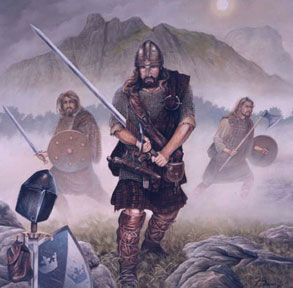|
William Wallace:
Freedom fighter of Scotland
by Premasara EPASINGHE
In world history, there are many heroes. They may be political or
military leaders. Sometimes, they fought for the freedom of their
country. Therefore, their names are engraved in gold in the history of
their countries. Some leaders, spring up, from political and social
obscurity.
|

William Wallace in battle |
They become, the first leaders of their people, in wars of
liberation. Some of them, achieve command for some time or few years,
but some who do not possess experience in good governance, fall by the
wayside.
This national hero of Scotland reminded me so much of our own freedom
fighter Veera Puran Appu. Of course he was captured, but he was not
executed in the way William Wallace's tragic ending.
Scotland's national hero William Wallace, of Elderslie is a son of a
country knight who came to fame, as he fought the Scotland against
Edward I's aggressive imperialism. It is true that William Wallace
achieved command, but he was unable to retain it. After the defeat at
the Battle of Falkirk, he was captured and King Edward I, brutally
killed him.
I presume, in world history William Wallace's killing, was the most
brutal. King Edward I, really took vengeance and he did it under the
most brutal fashion in a very inhumanly manner. In 1297, William Wallace
led the rebellion and defeated the English forces at Stirling Bridge.
In 1305, the English put Wallace to death as a traitor.
In 1306, Robert the Bruce becomes King Robert and was crowned in at
Scone. After a defeat he spent a year in exile.
As a student of history, it is difficult to study the true picture
about William Wallace as there is no real available evidence about his
life in the history of Scotland. Some reports are vague. Of course,
William Wallace was the centre of attraction for many novel, film (brave
heart), and Victorian statues.
The primary research centres found the study of Blind Harry's -
Wallace Epic.
It is stated, that a verse biography which was written in Latin by
Blair, the Chaplain of Wallace was the main source and Blind Henry or
Harry was influenced by this biography probably. Of course, he may have
added something more.
Battle of the Stirling Bridge
The greatest victory that William Wallace scored in the battlefield
was the "Battle of Stirling Bridge" King Edward I, sent a large army
under Hugh de Clissingham to Strivelin (Stirling). On September 11,
1297, at the bridge over River Forth, the England Commander Clissingham
was killed.
Then in the same year, 1297, William attacked England - the land of
Allerdale, was burnt down by him and carried the "Booty" to the kingdom
of Scotland.
The battle of Falkirk
The Scots garrisoned in the North of the River Sterline attacked the
Englishmen as they crossed the Stirling Bridge. He was assisted by Muray
and who sustained injuries and died.
The Battle of Falkirk marked the downfall of William Wallace. In July
22 1298, a pitched battle was fought. Robert of Bruce, (who ruled
Scotland later) cross-sides and fought on the side of Edward I. Moray,
who was an able leader of William Wallace died earlier and this was a
great blow for William Wallace.
At the outset, William Wallace, seized control of the Government, and
became the leader of the people of Scotland, in a war of liberation. His
enemy was England.
For nearly 60 years the wars ruged between Scotland and England. The
Scalacronica of Sir Thomas Grey very vividly describes the wars between
the Scottish and English in the late thirteenth and early fourteenth
centuries.
After the battles of Falkirk, Fordoun, Bower Robert Bruce, were
largely responsible for Falkirk disaster, William Wallace was badly
defeated.
William Wallace's trial was one sided. The trial was never a fair
one. He was charged with treason. The trial was not to prove the guilt
of Wallace, but it was a Trial which demonstrated the might and power of
the king of England - Edward I. (The king Edward I, used this Trail to
show to the Scottish people, anyone who challenges the King resisted the
kingship of Edward I, will have to face horrible, terrible consequences
even at the time of their deaths.
The European History lessons - We learned at Nalanda Vidyalaya,
Colombo in late 1950, under the great history teachers of the calibre of
the late K.M.P. Rajaratne, Dr. Shelton Kodikara (who was the Vice
Chancellor of the University of Peradeniya) V.C. Goonetileke, former
Attorney General came to my mind.
William Wallace was supposed to be taken to the Scaffoled, dragged on
a hurdle behind a horse, for nearly four miles for the London city
dwellers to see the "Saga".
Thousands flock to see the rare sight. William Wallace was wrapped in
a tide. Scotland's Great Hero, William Wallace, was dragged from
Westminster to the Tower, from there to Aldgate, and final destination
of his fate, to Smithfield. He was given to hang by the neck, but not
until the last breath.
While William Wallace still alive, he was cut down. The War Hero was
not unconscious. His Torso was split. Organs removed.
They were burnt on a "Brazier", they say. William Wallace's head was
displayed on the famous London Bridge. Parts - four quarters of his body
were hung, displayed in New Castle, Berwick, Perth and Sterling - where
William Wallace routed the Englishmen - Edward I Army. William Wallace,
was a Great Man of Great Stature one time, but, King Edward I made him a
Man of yesterday. |

